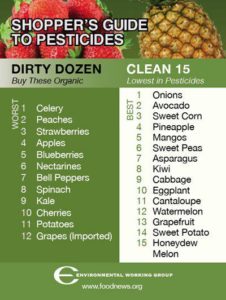
This is the latest research on pesticides and insecticides in our food. Buy organic or better yet – Grow your own.
Fruits and Pesticides
Apples – Cancer causers, hormone disruptors and neurotoxins have all been detected on apples, 98 percent of which test positive for pesticides. Because they’re so popular and are eaten daily by so many people, apples earned the top spot on EWG’s list of foods you should always buy organic.
Blueberries – More than 40 different pesticides were found on blueberries grown in the U.S.
Cherries – One of the most commonly used pesticides on cherries, carbaryl, is suspected of causing cancer and may lead to neurological diseases such as Parkinson’s and to birth defects.
Nectarines – The USDA found the average imported nectarine contained more pesticides by weight than any other food. Domestically grown nectarines didn’t fare much better. They contained the same range of pesticides, but at lower levels.
Peaches – Many of the pesticides used on peaches are systemic. They’re sprayed on a tree before it bears fruit, but the chemicals wind up getting into the fruit as it grows, and there’s no way to remove them.
Pears – 92 percent of pear samples tested positive for at least one pesticide residue, while 26 percent were tainted with 5 or more pesticides.
Imported Plums – The most common pesticide found on plums imported from abroad (mostly Chile) is iprodione, which the Environmental Protection Agency has dubbed a “likely” carcinogen.
Strawberries A single sample of strawberries tested by the USDA contained 13 different pesticides.
Grapes – More pesticides are used on grapes than on any other fruit. Combined, the various samples of grapes used in the 2012 EWG report contained 64 different pesticides.
Apples – Cancer causers, hormone disruptors and neurotoxins have all been detected on apples, 98 percent of which test positive for pesticides. Because they’re so popular and are eaten daily by so many people, apples earned the top spot on EWG’s list of foods you should always buy organic.
Blueberries – More than 40 different pesticides were found on blueberries grown in the U.S.
Cherries – One of the most commonly used pesticides on cherries, carbaryl, is suspected of causing cancer and may lead to neurological diseases such as Parkinson’s and to birth defects.
Nectarines – The USDA found the average imported nectarine contained more pesticides by weight than any other food. Domestically grown nectarines didn’t fare much better. They contained the same range of pesticides, but at lower levels.
Peaches – Many of the pesticides used on peaches are systemic. They’re sprayed on a tree before it bears fruit, but the chemicals wind up getting into the fruit as it grows, and there’s no way to remove them.
Pears – 92 percent of pear samples tested positive for at least one pesticide residue, while 26 percent were tainted with 5 or more pesticides.
Imported Plums – The most common pesticide found on plums imported from abroad (mostly Chile) is iprodione, which the Environmental Protection Agency has dubbed a “likely” carcinogen.
Strawberries A single sample of strawberries tested by the USDA contained 13 different pesticides.
Grapes – More pesticides are used on grapes than on any other fruit. Combined, the various samples of grapes used in the 2012 EWG report contained 64 different pesticides.
5 Pesticide Foods to Avoid and Why:
1. Peaches. Farmed peaches are number one because so many pesticides are needed to grow them. Their skin absorbs much of it infecting the flesh with carcinogenic chemicals that outweigh the peach’s natural health benefits.
2. Apples. Many apples are grown in mid-western states where they are not native and haven’t developed natural defenses to predators. They are treated with many harmful pesticides that seep into the peel. You can peel your apples but lose a third of the nutrients and some flavor.
3. Sweet Bell Peppers. This vegetable has the highest likelihood of containing multiple pesticides (64 found on a single sample)
4. Celery. This vegetable has no skin and the pesticides are absorbed directly into the plant. It’s best to buy this fresh and organic.
5. Strawberries. Their skin doesn’t absorb as much as a peach but they are small and we don’t often wash them carefully. The Organic Trade Association stated that more than 371 pesticides are approved for use on U.S. strawberries and because they grow close to the ground, they are subject to chemicals used on soils.
The Dirty Dozen
When it comes to these items, try to buy these in organic form to avoid the excessive amounts of pesticide.
1. Strawberries
2. Celery
3. Apples
4. Peaches
5. Spinach
6. Nectarines
7. Kale/collard greens
8. Sweet bell peppers
9. Lettuce
10. Blueberries
11. Potatoes
12. Grapes
The Clean 15
These 15 produce items are known by the EWG as the “clean 15″. They have the least amount of pesticides and would be considered the items to buy if you can’t afford to go completely organic.
1. Grapefruit
2. Sweet corn (This is generally GMO, so you may want to always stick to organic with corn)
3. Pineapples
4. Avocado
5. Mushrooms
6. Cantaloupe
7. Sweet potatoes
8. Eggplant
9. Sweet peas
10. Kiwi
11. Cabbage
12. Watermelon
13. Mangoes
14. Onions
15. Asparagus
Based on an analysis conducted over a period of time between 2001 – 2009 by the USDA and FDA, 53 popular produce items were tested creating a series of 51,000 tests. The produce items were rinsed and peeled to recreate the general conditions in which they are consumed. The conclusion of the analysis confirmed that if someone were to eat from the clean 15 and purchased organically from the dirty dozen, they would lower their pesticide intake by 92%.
When it comes to these items, try to buy these in organic form to avoid the excessive amounts of pesticide.
1. Strawberries
2. Celery
3. Apples
4. Peaches
5. Spinach
6. Nectarines
7. Kale/collard greens
8. Sweet bell peppers
9. Lettuce
10. Blueberries
11. Potatoes
12. Grapes
The Clean 15
These 15 produce items are known by the EWG as the “clean 15″. They have the least amount of pesticides and would be considered the items to buy if you can’t afford to go completely organic.
1. Grapefruit
2. Sweet corn (This is generally GMO, so you may want to always stick to organic with corn)
3. Pineapples
4. Avocado
5. Mushrooms
6. Cantaloupe
7. Sweet potatoes
8. Eggplant
9. Sweet peas
10. Kiwi
11. Cabbage
12. Watermelon
13. Mangoes
14. Onions
15. Asparagus
Based on an analysis conducted over a period of time between 2001 – 2009 by the USDA and FDA, 53 popular produce items were tested creating a series of 51,000 tests. The produce items were rinsed and peeled to recreate the general conditions in which they are consumed. The conclusion of the analysis confirmed that if someone were to eat from the clean 15 and purchased organically from the dirty dozen, they would lower their pesticide intake by 92%.


